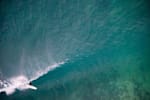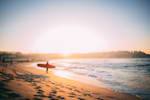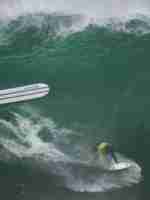There’s something truly extraordinary about longboarding with friends. Certainly, learning to longboard (or, learning to surf on a longboard) is far easier than learning on a shortboard…or whatever the pros on the WSL world tour are riding. The reason being, is mere surface area; on a longboard, you have about 40% more surfboard to find your balance on (we’ll get to those details a little later). Longboarding, however, is ultimately a cruisier way of surfing. You’re normally on smaller waves, catching more of them, riding for longer lengths of time (than on a shortboard), and you’re also able to do different maneuvers on the craft. At the end of the day with all those factors combined: you’re just plain able to surf more while on a longboard.
What exactly do you need in order to longboard?

Unknown Hero, Pipeline
© Ryan Miller
Just a few things, really…A swimsuit or wetsuit (depending on water temp), fin(s) for the board, surf wax, leg leash, sunscreen, and of course, a longboard. You can purchase most of these items from most surf shops. Most longboards definitively start at 9’0”—and go up into the 12-foot range. As a beginner surfer, however, we’d recommend 9’0” or 9’6” with stock dimensions.
Where do you go to longboard surf?

Longboard
© Alex King on Unsplash
It is definitely true that there are surf breaks more suited for longboarding, and others that are not. The ones that are not: break quickly, hard, and in shallow water. Like Pipeline, for instance. More longboard friendly waves break slowly, longer and are often smaller in height (1 to 4-feet high on the face of the wave). So, like, knee to chest-high.
Let’s talk about etiquette or the Surfers’ Code so we can maintain some order out there. Indeed, before blindly sprinting into the sea, chill out and watch the break from shore for a little while. Stretch a little and observe where and when most people are paddling out (entering the surf break). Does it look like a current is pulling surfers one way or another? Are there any submerged rocks or reef to avoid? Where, exactly, is the pack sitting and waiting for waves? Are there lulls between “sets” (a group of waves)? These are all important things to be aware of before paddling out.
Now, to the etiquette part. Once you paddle out there, sit to the side for a little and watch where people are catching waves. Don’t just paddle straight into the pack or to the peak—that’s just rude to other surfers who’ve been waiting their turns longer than you. If there is a channel (the deeper area where the waves don’t break), paddle through there. You can normally see “channels” from the shore. Never paddle out through the surf or through the lineup. If a surfer is riding a wave and is coming toward you, paddle in the opposite direction of where the surfer is headed. Also, ALWAYS hold on to your board. Ditching it can seriously injure someone behind you.
Once out there, be respectful. Be polite, don’t be loud, and try not to get in other folks’ way.
As far as “The Code”: the person who is closest to the peak (where the wave breaks) has the right of way. Usually, one person surfs per wave, unless it’s you and your friends out and you’ve agreed to share. If you’re at a surf break with one “takeoff spot,” (or, where most people are catching the waves at) wait your turn, and move toward the peak on rotation with others. It’s bad form to paddle around surfers to get into position.
How to longboard surf?

As this is a “how to longboard surf” as opposed to “how to surf at all,” we’re assuming you know the bare-basics. As in—paddling and popping up to stand on your board. Both of these things can be practiced on dry land, by the way, to refresh. The great thing about longboard surfing (as opposed to other, shorter surfboards), is that they’re far easier to balance on and ride.
Say, things have gone as planned, you’ve picked the right wave to longboard, assessed the conditions, stretched, paddled out and inevitably popped up to your feet—let’s get that stance right on a longboard. Once up, bend your knees a little, keep your body low, shoulders over your toes and your feet apart at about shoulder width. If you feel an imbalance while standing on your longboard (stand up in the bottom third area of the longboard BTW) make small adjustments to find your balance by scooting forward or back. If you’re too far forward you’ll “pearl” or nose-dive; too far back and you’ll hinder your momentum by stalling.
If you’ve angled your longboard to the right while facing the shore (for a “right”) or to the left (for a “left”), you’ve popped up and are going down the line (riding the wave), practice turning by changing slight pressure from heel to toe, shifting your weight at the hips simultaneously. These micro-maneuvers can lead into the first valuable longboard maneuver called a “bottom-turn.”
While getting to your feet and setting your stance, shift your feet back towards the tail, adjust your weight slightly, and lean on your heels or toes (depending which direction you’re going down the line). Then, bring your stance back to normal once the board is moving parallel to the wave wall, and you’re going down the line.
Once you’ve done a bottom turn, what’s known as a “top turn” is a redirection to complete the bottom turn and return proper balance to the board. Basically, like a bottom turn in reverse, leaning back on your heels to redirect and maintain balance. A “cutback,” is a glorified top-turn, where, while getting way back on the tail, you lean into a turn, swing the nose of your board around and change directions 180-degrees.
OK. But what’s a hang-ten? The “ten” are your toes (all ten of them), a relatively more advanced longboard maneuver where you walk toward the nose of your board and stylishly hang those 10 piggies over the nose. This is accomplished by finding a wave that’s long enough to allow you to “trim.” Trimming, is where, at the top half of a wave, your tail locks into the curl (by equalizing your own velocity with the wave’s speed) allowing you to walk up and down the length of your longboard. Instead of shuffling, by the way, most “cross-step,” it’s actually more efficient. Anyways, once trimmed, you can cross-step to the nose of your board, hang ten and not nose-dive. A “cheater-five,” is a maneuver where, for safer balance, you stick one foot toward the nose (five toes), with your body a foot or two back toward the tail for more stability.
Watching some longboard-centric surf videos helps to illustrate this well, like: The Endless Summer 1 and The Endless Summer 2, both required viewing for any surfer.
Of course, you can also just style-out and cruise, doing nothing at all down the line, just glide, being at one with longboard and sea…





Recent Comments